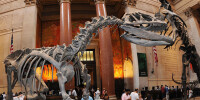Suvendu Das Review of A.M.M.H.
The American Museum of Natural History is one of t...
The American Museum of Natural History is one of the world s preeminent scientific and cultural institutions. Since its founding in 1869, the Museum has advanced its global mission to discover, interpret, and disseminate information about human cultures, the natural world, and the universe through a wide-ranging program of scientific research, education, and exhibition.
The Museum is renowned for its exhibitions and scientific collections, which serve as a field guide to the entire planet and present a panorama of the world's cultures.
The Biodiversity and Environmental Halls offer a vivid and inspiring vision of the spectacular beauty and abundance of life on Earth.
Ninety miles north of New York City in Dutchess County lies Stissing Mountain and the village of Pine Plains. Here, as in other parts of the world, each individual feature of the landscape is the home of definite plants and animals whose lives depend upon their environment and upon each other.This hall is intended to give you a better understanding of a living landscape.
The Hall of Biodiversity presents a vivid portrait of the beauty and abundance of life on Earth, highlighting both biodiversity and the factors that threaten it.
Ecological biodiversity is illustrated by a 2,500-square-foot walk-through diorama that depicts part of the Dzanga-Sangha rain forest, one of Earth s most diverse ecosystems. Featuring more than 160 species of flora and fauna, the diorama uses video and sound to re-create the ecosystem at dawn, at an elephant clearing, and degraded by human intervention along a road.
The hall s Spectrum of Life exhibit showcases the diversity of life resulting from 3.5 billion years of evolution. More than 1,500 specimens and models, from microorganisms to terrestrial and aquatic giants, are organized into 28 groups along the 100-foot-long installation.
The Hall of North American Forests explores the ecology and variety of the forests of North America from a northern spruce and fir forest of Ontario to a giant cactus forest in Arizona in addition to highlighting the forest food web and presenting techniques for protecting forests.
The hall also features a slice of a 1,400-year-old sequoia tree, underscoring the immense size and longevity of this species, as well as a display that illustrates how environmental stresses such as defoliation, windstorms, and fire can affect tree growth.
The Milstein Family Hall of Ocean Life highlights the drama of the undersea world and its diverse and complex web of life in a fully immersive marine environment. The hall is home to one of the Museum s most celebrated displays a 94-foot-long, 21,000-pound model of a blue whale suspended from the ceiling.
It was in the ocean about 3.5 billion years ago that the first life on Earth arose. Today, the planet s oceans are home to an amazing diversity of life in a wide range of habitats, from tropical coral reefs to the frigid polar seas. Still, many parts of the ocean are poorly known, and less than 5 percent of the deep ocean has been explored. For every new species, there may be hundreds more yet to be discovered.
The 29,000-square-foot hall features models of more than 750 sea creatures, ranging from tiny green bubble algae to computerized glowing jellyfishes. The hall also includes high-definition video projections, interactive computer stations, hands-on models, 14 classic dioramas, and eight ocean ecosystem displays that transport visitors from the profusion of life in the Indo-Pacific coral reefs to the bioluminescent fishes in the eerie darkness of the deep sea.

Comments: